
Logan and Albert Conservation Association

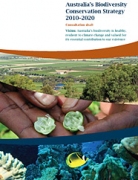 If you would like a hard copy of Australia's Biodiversity Conservation Strategy 2010-2020, please use the order form available here or you can download a copy here.
If you would like a hard copy of Australia's Biodiversity Conservation Strategy 2010-2020, please use the order form available here or you can download a copy here.
A Working Group has proposed a national approach to deliver a range of cost-effective national actions to reduce the impact of system-wide threats that are underlying causes of decline in biodiversity.
The approach focuses on three system-wide threats to biodiversity, where existing responses should be enhanced and where national scale attention is needed for new actions:
Drivers of loss of habitat values and decline in ecosystem function [ major issue for koala survival]
Spread of invasive pests, weeds and diseases
Climate change impacts on biodiversity.[major issue for koala survival]
CLOSING DATE FOR SUBMISSIONS 29 MAY 2009
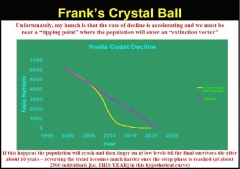 Koala campaigners are talking about the probable acceptance by federal government of the Australian Koala Foundation's (the AKFs) Nomination for the Koala Coast Koalas to be federally listed as endangered - with gazettal taking until September. However sobering research which some local councils are relucant to accept indicate that the tipping point has already been reached. The koalas in the Koala Coast area are genetically different and unique and their numbers are now below what ecologists believe is a sustainable population.
Koala campaigners are talking about the probable acceptance by federal government of the Australian Koala Foundation's (the AKFs) Nomination for the Koala Coast Koalas to be federally listed as endangered - with gazettal taking until September. However sobering research which some local councils are relucant to accept indicate that the tipping point has already been reached. The koalas in the Koala Coast area are genetically different and unique and their numbers are now below what ecologists believe is a sustainable population.
The urban Koala Matrix and the need to revegetate Good Quality Agricultural Land are vital components of the jigsaw to protect habitat for koalas. Koalas are disappearing out of Tanah Merah, Cornubia and Koala Coast Perimeters.
Included here is a copy of the powerpoint presentation delivered by Professor Frank Carrick from Queensland University koala research unit recently.  koalas_franksmall1.pdf 545.17 Kb 13/04/2009, 12:26
koalas_franksmall1.pdf 545.17 Kb 13/04/2009, 12:26
If you'd like more information about Koala Population crash, Koala Taskforce Report or BREC KOALA SUBMISSION for the Regional Plan contact Ted Fensom.
More information about QU koala research team is available here.
Queensland State Government Koala task force meets 17th April 2009
What can we do?
Ms Bligh said the reformed government would see 13 new departments lead by the government's 18 Ministers grouped under six clusters - Policy and Fiscal Coordination, Employment and Economic Development, Environment and Sustainable Resource Management, Social Development, Law, Justice and Safety and Government Services.
 Summary of changes to Queensland government following March 2009 re-electionis available in this document.
Summary of changes to Queensland government following March 2009 re-electionis available in this document.  summary_of_changes_qld_govt_2009.pdf 50.06 Kb 05/04/2009, 22:50
summary_of_changes_qld_govt_2009.pdf 50.06 Kb 05/04/2009, 22:50
The names of ministers and their portfolio/s are summarised in this document from propertyoz.com.au here.  queensland_government_ministry_march_2009.pdf 231.72 Kb 05/04/2009, 22:57
queensland_government_ministry_march_2009.pdf 231.72 Kb 05/04/2009, 22:57
As the American nation's leading conservation group creating urban parks and livable cities, The Trust for Public Land commissioned a report that addresses climate change and urban parks. Urban green space serves diverse purposes, ranging from neighborhood and city parks to river parkways, bike paths, and street trees, which in turn can produce different types of greenhouse gas benefits.
This white paper, prepared by ICF International, outlines the greenhouse gas benefits of adding green space to an urban area and introduces methodologies for estimating potential greenhouse gas reductions. The Trust for Public Land hope this paper will generate discussion about the need to create green livable cities, prompt new research on the benefits of parks to cities, and help government leaders in planning livable cities that reduce greenhouse gas emissions. 43 pages. Download the white paper [2.3 MB] from this page
 Today many factors conspire to keep kids indoors, yet a growing body of research indicates that the shift away from unstructured outdoor play is detrimental to healthy child development. Free play - especially in nature or at creative playgrounds - is essential to cognitive, physical, social, and emotional development.
Today many factors conspire to keep kids indoors, yet a growing body of research indicates that the shift away from unstructured outdoor play is detrimental to healthy child development. Free play - especially in nature or at creative playgrounds - is essential to cognitive, physical, social, and emotional development.
Many experts have called attention to the issue, most notably author Richard Louv, whose best-selling book Last Child in the Woods: Saving Our Children from Nature-Deficit Disorder (newly revised edition) has been translated into six languages. "Passionate memories of a childhood spent in nature are nearly universal," Louv says. "It doesn't seem to matter what somebody's politics are or religion is. These memories are something we share in common. Except for younger people."
Stuart Brown, a neuroscientist and president of the American National Institute for Play, says that various factors have contributed to the demise of childhood play in nature. One is the perceived risk to children who are outside without adults, a perception derived from high-profile media stories about child abductions, which in fact are relatively rare. Another trend is that "free time" has become an oxymoron for many children, whose nonschool hours are packed with organized, achievement-oriented activities.
 Tom Philpott farms and cooks at Maverick Farms, a sustainable-agriculture nonprofit and small farm in the Blue Ridge Mountains of North Carolina. It is also an educational farm dedicated to promoting family farming as a community resource and reconnecting local food networks. His article Toward a less efficient and more robust food system is a version of an address delivered before the High Country Local Food Summit where he spoke about how to create a robust, diversified food system. Read the article here in http://www.grist.org/article/2009-toward-a-less-efficient-and-more-robust/
Tom Philpott farms and cooks at Maverick Farms, a sustainable-agriculture nonprofit and small farm in the Blue Ridge Mountains of North Carolina. It is also an educational farm dedicated to promoting family farming as a community resource and reconnecting local food networks. His article Toward a less efficient and more robust food system is a version of an address delivered before the High Country Local Food Summit where he spoke about how to create a robust, diversified food system. Read the article here in http://www.grist.org/article/2009-toward-a-less-efficient-and-more-robust/
The comparisons between specialized "city of the future" Manchester and Birmingham with a lot of little organizations doing bits and pieces of work for other little organizations ie working together, forming networks, and loose informal cooperatives provide food for thought. Birmingham flourished, Manchester did not.
Where will our food come from in the future?
 The ability to grow and interest in growing and eating our own locally produced food is growing. Alan Chenoweth (Chenoweth Environmental Planning & Landscape Architecture); Robert Pekin (Food Connect - an Australian leader in responsible food production and distribution) & Jan Power (Jan Powers Farmers Markets) are guest presenters at a free evening of presentations.
The ability to grow and interest in growing and eating our own locally produced food is growing. Alan Chenoweth (Chenoweth Environmental Planning & Landscape Architecture); Robert Pekin (Food Connect - an Australian leader in responsible food production and distribution) & Jan Power (Jan Powers Farmers Markets) are guest presenters at a free evening of presentations.
Title: PRODUCE, SHARE and ENJOY: Food in the city
What: Free public seminar featuring three exciting speakers
When: 06 May 2009 6:00pm
Where: The Brisbane room - Brisbane City Hall
Cost: FREE ADMISSION - BUT PLEASE BOOK A PLACE RSVP: 04 May 2009 12:00am 3220 2198 or Email www.brisinst.org.au
Food in the City ---- A step towards making Brisbane "local food smart"
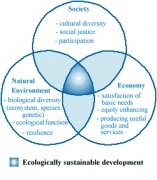 The Draft South East Queensland Regional Plan 2009-2031 adopts uncontrolled population growth, ignoring any consideration of a population cap for SEQ. Not to limit population growth is to accept that our lifestyles and environment will be destroyed irrevocably and that our water, mineral and other resources will be depleted sooner rather than later. Australian Bureau of Statistics (ABS) data shows that the population of SEQ is increasing at about 1.8 per cent per year; about 41% due to net overseas migration, 39% due to natural increase (the excess of births over deaths), and 20% attributable to net interstate migration.
The Draft South East Queensland Regional Plan 2009-2031 adopts uncontrolled population growth, ignoring any consideration of a population cap for SEQ. Not to limit population growth is to accept that our lifestyles and environment will be destroyed irrevocably and that our water, mineral and other resources will be depleted sooner rather than later. Australian Bureau of Statistics (ABS) data shows that the population of SEQ is increasing at about 1.8 per cent per year; about 41% due to net overseas migration, 39% due to natural increase (the excess of births over deaths), and 20% attributable to net interstate migration.
In 2009, SEQ suffers from many population-induced pressures, including:
a. increasing road congestion;
b. increasing atmospheric and noise pollution;
c. increasing pressure on medical and education resources;
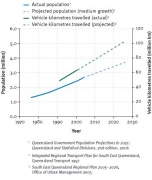 If you are concerned about how crowded South East Queensland will become according to these EPA projections of traffic growth through to 2030, MAKE A SUBMISSON TO DRAFT SOUTH EAST QUEENSLAND REGIONAL PLAN.
If you are concerned about how crowded South East Queensland will become according to these EPA projections of traffic growth through to 2030, MAKE A SUBMISSON TO DRAFT SOUTH EAST QUEENSLAND REGIONAL PLAN.
Redland City Mayor Melva Hobson said there were a number of important issues raised by the draft SEQ regional plan that the Redlands and other SEQ Council's wanted addressed, before the plan becomes final. There are serious gaps in infrastructure, including provision for vital transport links to meet past growth, let alone the substantial growth the new plan projects for the SEQ Region.
Logan and Scenic Rim residents know only to well the shortages and absences in many areas of acceptable public transport. Education and health provisions are also inadequate to meet the needs of the current population.
Community consultation processes can be withdrawn by the Minister. This also negates all the planning processes of the local council if the draft regulatory provisions are accepted and we allow the Minister to simply change the urban footprint by administrative fiat. Read article in the online bayjournal.com.au
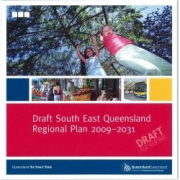 The Scenic Rim Regional Council has placed its 2009 submission to the Draft SEQ Regional Plan Review dated 30 March 2009 into the public domain. Since citizens now have an extended opportunity to comment on draft SEQRP until1 May 2009 you may wish to read and consider making your own new or revised submission. Read and download SRRC submission from this page.
The Scenic Rim Regional Council has placed its 2009 submission to the Draft SEQ Regional Plan Review dated 30 March 2009 into the public domain. Since citizens now have an extended opportunity to comment on draft SEQRP until1 May 2009 you may wish to read and consider making your own new or revised submission. Read and download SRRC submission from this page.
Documents on that page include